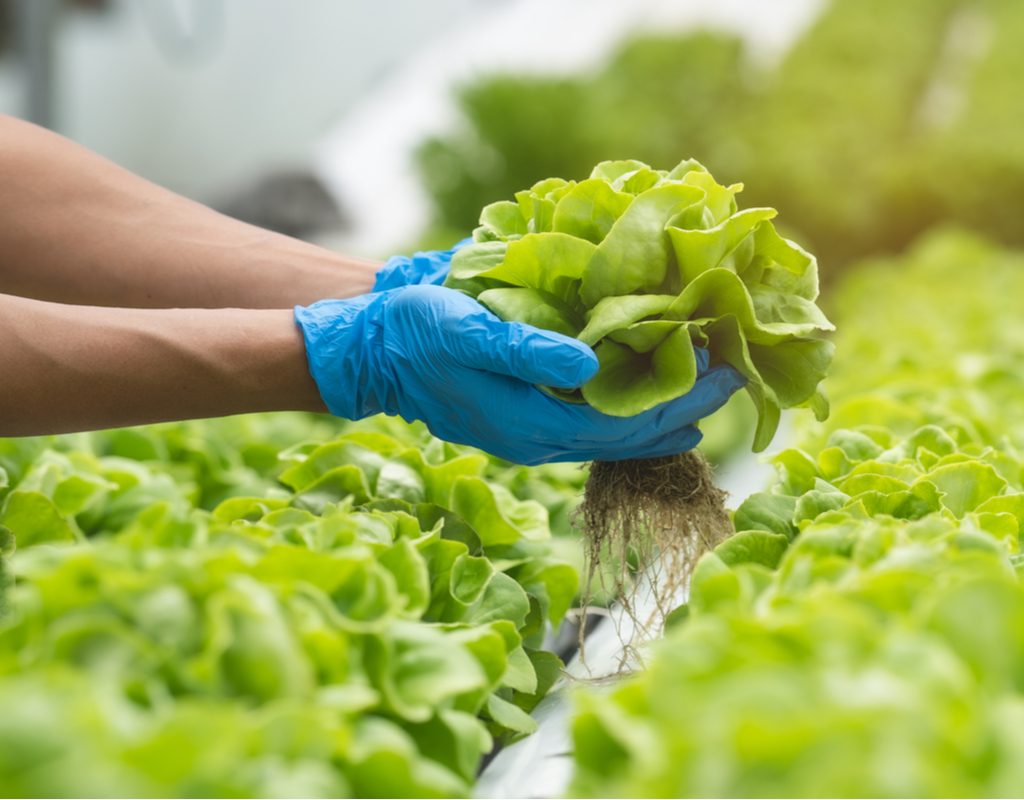As far as indoor crops go, lettuce is one of the easiest to grow and maintain. Whether you’re growing lettuce indoors under lights or just using the natural lighting in your home, you’ll be able to have thriving crops so long as you provide a proper, controlled environment. With the right care, you’ll be able to enjoy fresh, harvested lettuce year-round!

Benefits of growing lettuce indoors
Although many people will gravitate to organically grown vegetables as a way to be healthier, “organically grown” doesn’t always mean “chemical free.” Possibly the biggest benefit of growing your own lettuce at home is that it will help ensure you don’t consume any unwanted chemicals or toxins (not to mention buying seed packets may be more cost-effective than buying a new package of organic lettuce each week).
One of the beautiful parts about growing your own lettuce is that you’ll only have to harvest what you need at any given time. When you buy lettuce at the store, everything has already been cut and needs to be used in a timely manner, otherwise it goes bad. By only harvesting what you need for a salad or a sandwich, you’ll allow the rest of the leaves to continue growing and stay healthy until they’re needed. Lettuce is also one of those crops that prefers a more stable environment, so it has the potential to thrive more indoors.
The best environment for growing lettuce indoors
Most of the time when you ask yourself, “How much light does lettuce need?” the question will be answered on the back of the seed packet! If you find your indoor environment can’t provide that amount of light per day (especially in colder months), you can always invest in grow lights to supplement. According to the study by OSU, “lettuce maintained its highest photosynthesis rate for about seven or eight hours after the lights came on,” meaning your lettuce will perform best at a minimum of eight hours a day. Growing lettuce indoors under lights will help meet this requirement if you’re in a darker space or a house with more indirect lighting.
Many varieties of lettuce prefer a cooler environment — thriving at around 60° to 65° — so you don’t want to keep them in an area that’s incredibly hot or humid. If you’re thinking about starting a basement garden, lettuce would be a good crop to grow. Luckily, growing indoors will mean your environment will be more controlled. This means you can adjust temperature, amount of light, location, etc., as needed and don’t have to worry whether your lettuce is getting too much of one particular thing.
Don’t forget the photoperiod
When we look at how much light lettuce needs, we have to consider its photoperiod. The photoperiod of any plant is also known as its day length, or the amount of time it’s exposed to daylight during a 24-hour period. The Department of Horticulture at Ohio State University (OSU) completed a study that estimated lettuce’s photoperiod was somewhere between 12 and 20 hours (which, for them, meant that the crop didn’t have a specific day length).
OSU concluded that a “shortened light cycle gave leaves a more compact and round shape, reducing self shading, allowing for a higher planting density but longer light cycle, one closer to the circadian rhythm of a plant, allowing for more slender and open leaves for better light interception.”
There are, however, variations between different types of lettuce. It’s always best to follow the directions for the specific variety you’re growing as most will indicate the photoperiod on the seed packets. A general rule of thumb is that, for best growth, lettuce will require at least eight hours of sunlight a day to ensure strong growth.

How to harvest indoor lettuce
Something to keep in mind is that even though homegrown lettuce will last longer than lettuce purchased at a store, it is still perishable. Lettuce plants will not live and produce new leaves forever; however, it is possible to keep a continuous harvest going throughout the year if that’s something you’re interested in.
When growing outdoors, gardeners will plant lettuce in batches about two weeks apart throughout the beginning of the season. This can be adapted to indoor growing using different pots/containers. You can start one set from seed in a container, then sow another set of seeds a couple weeks later. This will keep your harvest continuous throughout the year, and you can do this as much as you want so long as you have the containers and the growing space.
Once the leaves are about four inches long, they’ll be ready for harvest. You’ll want to start from the outer leaves and work your way in when harvesting, mimicking how you would break apart a head of lettuce purchased at the grocery store. This lets you use the biggest leaves first and gives the smaller leaves a chance to continue growing.
Growing lettuce indoors is one of the easiest places to start if you’re new to indoor vegetables. If you find you’re interested in branching out, there’s a whole world of indoor, basement, and small deck/patio gardening that awaits!


